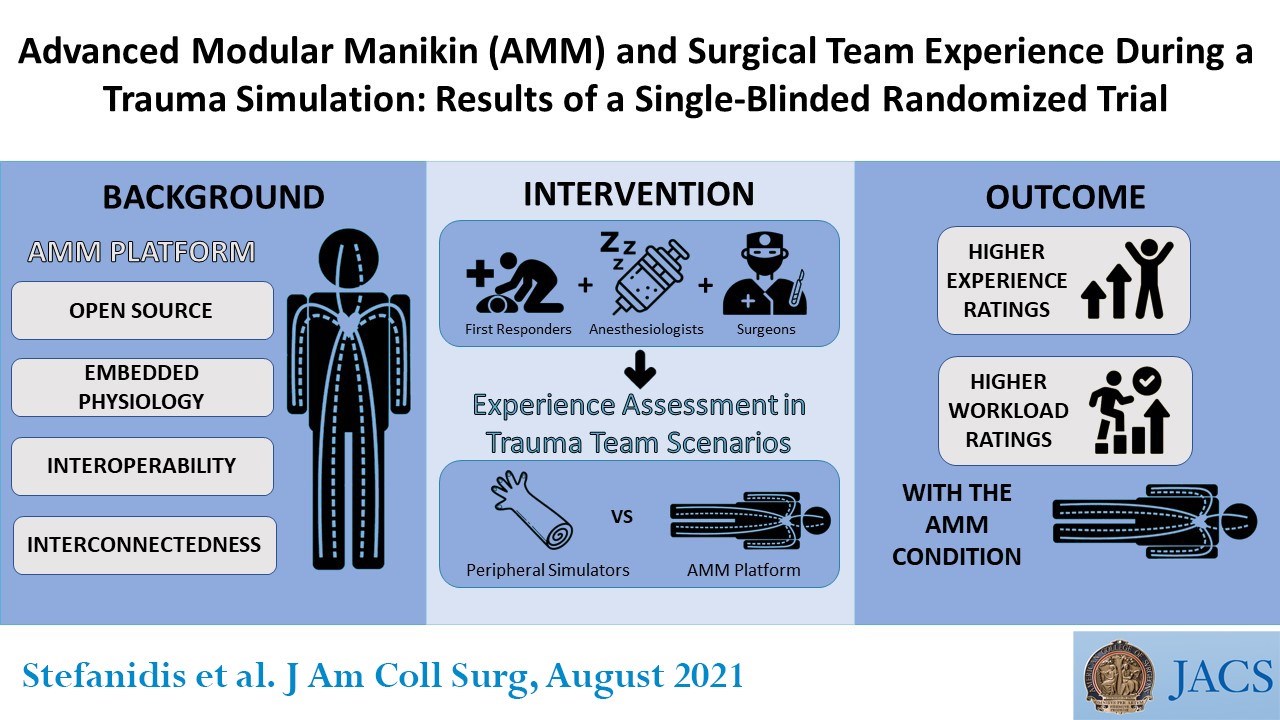CHICAGO: Simulators have long been used for training surgeons and surgical teams, but traditional simulator platforms typically have a built-in limitation: they often simulate one or a limited number of conditions that require performance of isolated tasks, such as placing an intravenous catheter, instead of simulating and providing opportunities for feedback on the performance of multiple interventions that a trauma victim may require at the same time. To overcome this limitation, the Advanced Modular Manikin (AMM), an innovative simulation platform that allows integration of other simulation devices, was developed and field testing was conducted, with support from the Department of Defense (DoD).
The DoD subcontracted with the American College of Surgeons (ACS) Division of Education to conduct field testing of the AMM. The results have been published online in advance of print by the Journal of the American College of Surgeons. Robert M. Sweet, MD, FACS, MAMSE, of the department of surgery at the University of Washington, served as principal investigator (PI) of the DoD contract to build the AMM. Ajit K. Sachdeva, MD, FACS, FRCSC, FSACME, MAMSE, Director, Division of Education, American College of Surgeons, served as the PI for the subcontract to conduct field testing.
The investigators reported that members of trauma teams at a testing site preferred the integrated AMM platform including a “peripheral” simulator over the “peripheral” simulator alone, in terms of realism, physiologic responses, and feedback they receive on the multiple and overlapping interventions they perform on a simulated trauma patient. Corresponding study author Dimitrios Stefanidis, MD, PhD, FACS, FASMBS, FSSH, of the department of surgery at Indiana University School of Medicine, Indianapolis, described the AMM as “more of a platform rather than a manikin.”
The DoD supported development of the AMM through a contract with the University of Minnesota and the University of Washington. The goal was to create an open-source simulation platform that permits integration of a number of simulators, known as “peripherals,” into a singular, comprehensive training platform. A Steering Committee composed of leaders and staff of the ACS Division of Education and the Research and Development Committee of the ACS-Accredited Education Institutes, along with leaders from the Development Team of the AMM Project created the model for field testing the AMM.
“The AMM platform, along with the ‘peripherals,’ can help to address the need for more robust simulators that focus on open procedures and interprofessional teamwork,” Dr. Sachdeva explained. “The ability to integrate the anatomic and physiologic elements of the simulation is an important advance. The experience with the trauma scenario may readily be extended to other surgical procedures and settings.”
Corresponding author Dr. Stefanidis explained that with most traditional simulators, instructors have to manipulate vital signs to respond to specific actions of the learner. He pointed out that the AMM promotes “a learner experience that is more based on the actual physiology of what’s happening to the patient.” The AMM platform allows different members of the trauma team to perform different tasks concurrently—one inserts a breathing tube, another starts an intravenous line, another performs a splenectomy. “All of these interventions impact the physiology,” he said.
The researchers evaluated team experience ratings of 14 trauma teams consisting of 42 individual members who performed tasks on the integrated AMM platform and the standalone “peripheral” simulator. Team experience ratings were higher for the integrated AMM platform as compared with the standalone “peripheral” simulator. Among the team members, surgeons and first responders rated their experience significantly higher than anesthesiologists, who noted higher workload ratings. In focus groups, the team members said they preferred the AMM platform because of its increased realism, and for the way it responded physiologically to their actions and the feedback it provided.
Dr. Stefanidis explained how the AMM can potentially aid in training trauma teams. “Trauma requires exemplary teamwork,” he said. “When we see patients who are injured, there are typically multiple providers who take care of them simultaneously—trauma surgeons, emergency room physicians, anesthesiologists, orthopedic surgeons, neurosurgeons, nurses, respiratory therapists, etc. So, it’s extremely important to also be able to train these teams in a low-stress simulation environment, such as by using the AMM, where they can hone their skills, individually and as a team, and perform at their best when faced with the very high-stress clinical environment.”
The AMM platform offers other benefits for improving the training and proficiency of trauma teams, said the field study PI, Dr. Sachdeva. “Specific training models could be standardized and the situation made increasingly complex in this safe simulation environment,” he said.
Study coauthors with Drs. Stefanidis, Sachdeva and Sweet are Rajesh Aggarwal, MBBS, MA (Cantab), PhD, FRCS, FACS, MAMSE, of the Department of Surgery, Sidney Kimmel Medical College, Thomas Jefferson University, Philadelphia; Robert M. Rush, Jr., MD, FACS, of PeaceHealth St. Joseph’s Medical Center, Bellingham, Wash.; Gyusung Lee, PhD, and Patrice G. Blair, MPH of the ACS Division of Education; David Hananel of the Department of Surgery, University of Washington, Seattle; Yoon Soo Park, PhD, of the Department of Medical Education, University of Illinois College of Medicine, Chicago; and Gordon G. Wisbach, MD, MBA, FACS, CAPT, MC, USN, of the Bioskills and Simulation Training Center, Naval Medical Center, San Diego.
The study authors have no relevant financial relationships to disclose.
“FACS” designates that a surgeon is a Fellow of the American College of Surgeons.
Citation: The Advanced Modular Manikin™ Enhances Surgical Team Experience During a Trauma Simulation: Results of a Single-Blinded Randomized Trial. Journal of the American College of Surgeons. DOI: https://doi.org/10.1016/j.jamcollsurg.2021.04.029.

